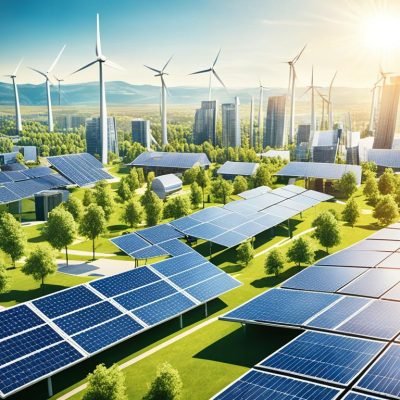More homeowners are switching to renewable energy to power their homes. Two popular choices are solar panels and wind turbines, each with unique benefits. Understanding their differences helps make the best decision for your needs.

Studies show that solar power outperforms wind in residential settings. Inland Power & Light found that solar panels generated five times more electricity than wind turbines over 14 months1. Additionally, solar systems meet over 95% of annual electricity needs for most homes1.
While wind contributes more to large-scale energy production, solar is more versatile for homes. Wind turbines need open space and consistent wind, while solar panels fit easily on roofs or yards1. Maintenance is also simpler with solar, as panels have no moving parts.
Key Takeaways
- Solar panels produce five times more electricity than wind turbines in residential areas.
- Most homes can meet 95% of their electricity needs with solar power.
- Wind energy is better for large-scale projects, while solar suits homes better.
- Solar panels require less space and maintenance than wind turbines.
- Wind power accounts for 24% of U.S. renewable energy, while solar makes up 9%.
Wind Energy vs. Solar Energy: Which is Better?
Efficiency and reliability vary significantly between these two power sources. While both harness natural forces, their real-world performance depends on location and conditions.
Energy Output and Conversion Rates
Solar panels typically convert 20–25% of sunlight into electricity, whereas wind turbines achieve 60–90% efficiency in ideal conditions2. This higher rate makes turbines a powerhouse for large-scale projects, especially in rural areas with steady winds3.
However, turbines need consistent wind speeds above 9 mph (14.5 km/h) to function optimally2. Without this, their output drops sharply. Solar panels, though less efficient, generate predictably during daylight hours.
Sunlight vs. Wind: Availability Matters
Solar systems stop producing at night, while wind can generate power 24/7 if conditions allow2. Yet wind’s inconsistency—requiring open, unobstructed locations—limits its reliability for many homeowners4.
Wind also holds a CO2 advantage, emitting just 4.64 grams per kWh compared to solar’s 70 grams2. But both face storage challenges during low-generation periods, necessitating backup solutions like batteries4.
Cost and Maintenance: Solar Panels vs. Wind Turbines
Financial considerations play a major role in selecting clean energy solutions. Homeowners must evaluate both upfront expenses and long-term care to determine the best fit.
Upfront Installation Costs
Solar panels are significantly cheaper to install, averaging $11,000–$15,0005. In contrast, a single wind turbine costs $50,000–$70,0005, making it a less accessible option for most households.
Solar also offers quicker returns. At 4.6 cents per kWh, its operational cost is 78% lower than wind’s 20.3 cents5. EnergySage reports homeowners save 25% by comparing solar quotes6.

Long-Term Maintenance Requirements
Solar systems require minimal upkeep due to no moving parts. Most come with 25-year warranties, ensuring decades of low-cost operation6.
Wind turbines, however, need frequent inspections, lubrication, and part replacements. These tasks add $1,000–$3,000 annually6, eroding their long-term value.
- Solar wins on affordability: Lower installation and kWh rates.
- Wind suits niche cases: Rural areas with subsidies or land leases7.
- Maintenance matters: Solar’s simplicity reduces lifetime costs.
Key Factors in Residential Suitability
Choosing the right renewable power source depends on several practical factors. Homeowners should evaluate their property’s space, location, and local weather patterns to determine the best fit.
Space and Location Considerations
Solar panels can be installed on rooftops or small plots, making them ideal for urban and suburban homes5. In contrast, wind turbines require at least 80 feet of open land to function efficiently8.
Rural properties with acreage may accommodate turbines, but most residential areas lack the necessary space. Solar’s compact design offers flexibility for tighter locations.
Noise and Aesthetic Impact
Turbines produce 45–50 decibels of noise—similar to a refrigerator—which can lead to complaints in quiet neighborhoods8. Solar panels operate silently, avoiding disruptions.
Aesthetics also matter. Turbines are highly visible, while solar systems blend into rooftops with minimal aesthetic impact5.
Local Climate and Energy Needs
Sunny regions like Florida maximize solar output, even on cloudy days9. Wind thrives in consistently gusty areas, such as coastal zones or the Great Plains8.
Household energy needs further guide system sizing. A 5kW turbine equals roughly 24 solar panels in output5.
| Factor | Solar | Wind |
|---|---|---|
| Space Needed | Rooftop/small yard | 80+ ft open land |
| Noise Level | Silent | 45–50 decibels |
| Climate Suitability | Sunny/cloudy regions | Windy plains/coasts |
| Wildlife Impact | Minimal | Risks to birds/bats |
Ultimately, solar suits most homes due to its adaptability, while wind remains a niche option for rural farms or leased land9.
Conclusion
For most households, solar panels offer the best balance of affordability and efficiency. They adapt easily to rooftops and require minimal maintenance, making them a cost-effective choice10.
Wind turbines excel in rural areas with subsidies or large land parcels, but their niche appeal limits widespread residential use11.
Consulting renewable energy experts helps tailor solutions to your needs. Tools like solar calculators simplify comparisons, ensuring a smooth transition to cleaner energy sources.








